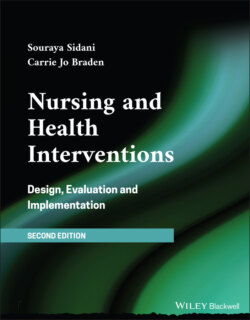Читать книгу Nursing and Health Interventions - Souraya Sidani - Страница 51
Identification of Factors
ОглавлениеCausative factors, risk factors, or determinants of the health problem are circumstances, events, conditions, or capabilities that contribute to its experience. It is now well recognized that multiple factors, taking place at different levels, conduce to the occurrence (e.g. Aráujo‐Soares et al., 2018; Golfam et al., 2015) or maintenance (e.g. Glanz & Bishop, 2010) of a particular problem. The factors exhibit in any domain of health and life, at the intrapersonal, interpersonal, social, and environmental levels (Bartholomew et al., 2016). Intrapersonal factors include biological characteristics (e.g. sex and age) and physiological, physical, behavioral, psychological, and cognitive conditions. Interpersonal factors entail challenges in the relationships between individual clients and others in their immediate environment (e.g. home, work) and the availability or accessibility of resources and support. Social factors relate to beliefs, values, and norms commonly held by a group or community. Environmental factors represent features of the physical, socioeconomic, and political setting or context in which clients reside (Craig et al., 2018).
In addition to identifying the types and levels at which the factors occur, it may be useful to (1) categorize them into factors that contribute to the development or to the maintenance of the health problem (Butner et al., 2015; Glanz & Bishop, 2010); (2) determine if and how they are inter‐related and (3) if they vary across populations and time. Overall, the factors can be categorized into predisposing, precipitating, and perpetuating factors as was done for factors contributing to insomnia.
1 Predisposing factors are usually innate characteristics that increase clients' susceptibility or tendency to experience the problem. This category of factors is illustrated with sex and age, which have been found to increase clients' vulnerability to experience insomnia.
2 Precipitating (also called enabling) factors are conditions or events that bring about or trigger the problem. This category of factors is illustrated with the onset of illness or stress‐related events that disrupt sleep.
3 Perpetuating (also called reinforcing) factors serve to maintain the problem. In the case of insomnia, perpetuating factors represent sleep habits or behaviors that clients engage in an attempt to deal with poor sleep but are ineffective.
